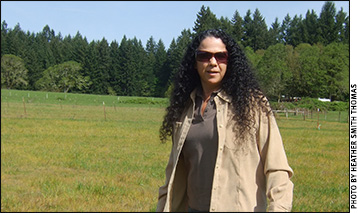Selenium Research
Research looks at supplementing selenium deficiencies.

“The plants growing in these pastures don’t require selenium, but they do require sulfur,” says Shelby Filley. “They can be fooled with this product (Selcote Ultra®), taking it in as if it were sulfur.”
Many areas in the United States are deficient in selenium (Se); forages grown in those soils are short on this important trace element. When livestock are short on selenium, they are at risk for numerous health problems — white muscle disease in calves, lambs and foals; weak hooves and weaker immune systems, among others. Stockmen often supplement with selenium, but now there may be a way to ensure better selenium levels in hay and pasture forages by fertilizing with sodium selenate.
Research on this strategy has been conducted in Oregon, most of which has selenium-deficient soils.
“One research project that OSU (Oregon State University) has done — in conjunction with the counties — addressed this problem,” says Shelby Filley, associate professor in the Department of Animal and Range Sciences, OSU Extension Service. “The county Extension people set out blocks of land across Oregon to do research in our different locations to validate the results for the entire state. For this project we fertilized ground with sodium selenate, using a product called Selcote Ultra®.
“The plants growing in these pastures don’t require selenium, but they do require sulfur,” Filley continues. “They can be fooled with this product, taking it in as if it were sulfur.” Thus the plants end up with higher selenium content than they would otherwise, and the forages are not deficient.
Selenium in excess is toxic to animals, warns Filley. “The most toxic form, however, is selenite. It behaves much differently in the animal’s body. The sodium selenate that ends up in the forage is in an organic form as part of the plant’s amino acid (protein) structure.”
The original studies conducted in New Zealand and the Oregon studies enabled researchers to safely increase forage levels of selenium, says Filley. “Studies were done in cattle and sheep, looking at their blood levels and their offspring’s blood levels of selenium to see how safe this would be if they were also getting injections of selenium.”
In selenium-deficient regions, it is a common practice to inject newborns with this trace mineral to reduce the risk of problems like white muscle disease in young calves and lambs.
“We wanted to know how safe it was to have the increased levels of selenium in forage if people were also adding selenium to a mineral supplement or injecting it. We haven’t seen any problems with the extra selenium; we have more problems in our area with selenium deficiency than with overdose,” she says.
Researcher Gene Pirelli worked with the Oregon Department of Agriculture to get its blessing on using sodium selenate as a fertilizer. Some producers are now using it.
“We do a lot of forage research here, trying to provide good feed and improved productivity for our producers,” Filley concluded. “We are grass farmers first and livestock producers second.”

Editor’s Note: Heather Smith Thomas is a freelancer and cattlewoman from Salmon, Idaho.





